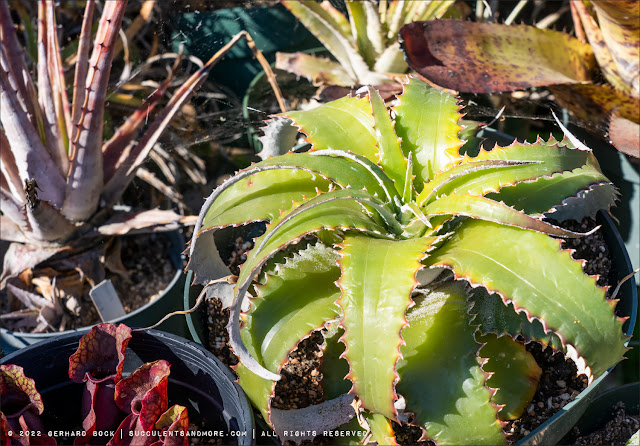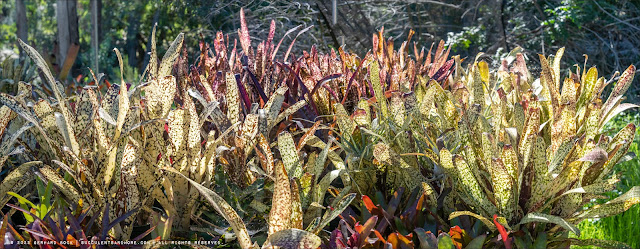One of the highlights of my San Diego trip in February was a visit with Andy Siekkinen. Andy is one of the world’s leading experts on hechtias, terrestrial bromeliads native to Mexico and Central America, with at least one (Hechtia texensis) also found in the U.S.
The genus Hechtia has been Andy’s research focus for a number of years. His master’s thesis, Systematics of Hechtia (Hechtioideae): Insights in phylogenetics and plastome evolution in a non-model organism with Next Generation Sequencing, examined the relationships between species based on next-generation DNA sequencing in order to reorganize the taxonomy of the genus from the ground up.
In 2020, Andy co-authored a paper formally describing five new species from the Mexican state of Guerrero: Hechtia elegans, H. ensifolia, H. medusae, H. platyphylla, and H. pycnostachya. In 2022, he again co-authored the formal descriptions of seven new species from the state of Puebla: Hechtia anarosae, H. dasylirioides, H. espejoana, H. longissimifolia, H. microcarpa, H. minimiflora, and H. vicesphaeroblasta. There's more to come yet; Andy is working on describing at least a dozen more hechtia species.
But Andy has more than just a scientific interest in hechtias. He also grows them. In fact, he has what has got to be largest collection of hechtias in the country, personal or institutional. His collection enables him to make valuable observations for future research, but it also allows him to be creative and make hybrids. Some hechtia species may not be the kinds of plants most people would want in their gardens, but others are beautiful. Crossing species that have desirable characteristics can result in hybrids that are truly special. One prime example is Hechtia ’Wildfire’, Andy’s cross between H. texensis and H. stenopetala, registered with the Bromeliad Society International in 2015. As you can see in the photo below, it really does look like it’s on fire most of they year.
 |
| Hechtia ‘Wildfire’, one of Andy's hybrids (my plant) |
There’s an additional factor that makes propagating and hybridizing hechtias more difficult: They are are dioecious, i.e. there are male plants and there are a female plants. To get seeds (or to create hybrids) you need plants of both sexes that are in flower are the same time. As you can imagine, the logistics involved can be pretty challenging.
While hechtias are particularly close to Andy’s heart, he also grows (and hybridizes) a wide variety of other bromeliads, ranging from aechmeas and billbergias to neoregelias and tillandsias. He has a large hoop house and a number of outside growing benches in his backyard in San Diego and also rents greenhouse space in another location.
Andy gave me a tour of both places, and I had to completely rethink the preconceived image that had been stuck in my head: What Andy is doing goes far beyond the scope of a hobbyist or casual backyard grower. He has the beginnings of a commercial operation going.
As you will see below, the sheer number of plants is breathtaking. This is not by coincidence. Andy is working hard on expanding his inventory and creating an ecommerce site that will allow him to sell plants on a much large scale than before. While his scientific interest might be focused on hechtias and other terrestrial bromeliads like deuterocohnias, he knows full well that there are far more prospective buyers for “softer” bromeliads such as billbergias and neoregelias. With their brilliant colors and dazzling markings, they practically sell themselves.
This post covers Andy’s operation at this house. The second installment is about the plants in the greenhouse he rents.
 |
| The hoop house in Andy’s backyard |
From the front of Andy’s house, which is set close to the street, you would never guess how large the backyard is—the lot is almost ⅔ acre. Considering that Andy lives in the city, not in the country, this is pretty darn amazing. I’d give a digit or two to have that much space!
The slope just below the patio is full of plants I love: aloes, agaves, cycads, cacti, even alluaudias and pachypodiums from Madagascar. As they’ve matured, they’ve formed the kind of cramscape I’m so fond of.
 |
| Variegated Dasylirion, probably actrotrichum. The first one I’ve ever seen! |
 |
| Flowering Agave titanota, Aloe ferox hybrid (flowering), and Aloidendron barberae |
 |
| The best kind of jungle, right in Andy’s backyard |
Now let’s take a look at Andy’s growing operation:
 |
| Tillandsias mounted on pieces of wood, ready for sale |
 |
| Hard to decide where to look first |
 |
| Billbergias in dazzling purples, pinks, and reds |
 |
| Tillandsia roseoscapa (left), Billbergia (amoena ‘Ed McWilliams’ × amoena var. rubra) × stenopetala (right) |
 |
| Billbergia vittata ‘Domingos Martins’ × buchholtzii |
 |
| Billbergia ‘The Riddler’ |
 |
| Neoregelia carcharodon ‘Rainbow’ |
 |
| Tillandsia ixioides seeds |
 |
| Dudleya brittonii seedlings. Yep, Andy likes dudleyas, too. He likes a lot of plants! |
 |
| Echeveria waltheri, a rare echeveria species from central Mexico |
 |
| Echeveria waltheri flowers |
 |
| Andy inside the hoop house. A raised walkway in the middle allows easy access to the plants on the upper level. |
 |
| Tables outside under 65% shade cloth |
 |
| My jaw dropped to the floor... |
 |
| ...when I saw the sheer number of plants... |
 |
| Billbergia ‘Casa Blanca’ |
 |
| Billbergia ‘Kolan Gift’ ב#1179’ with creamy white markings. Or is it the other way around? |
Yes, there were hechtias, too:
 |
| Left: Hechtia galeottii |
 |
| Hechtia sp. nova AS086 |
 |
| Hechtia lanata, glabrous form |
 |
| Hechtia ‘Ventura’ × lanata |
And some hohenbergias for good measure:
 |
| Hohenbergia ‘Chunky Monkey’ (tentative name) |
 |
| Hohenbergia leopoldo-horstii seedling |
 |
| Andy holding a massive Hohenbergia ‘Chalice’ |
To me, hohenbergias look like the product of a torrid love affair between a hechtia and a neoregelia. They deserve much more attention than they’ve traditionally gotten. Maybe Andy can help boost the public profile this underappreciated group of terrestrial bromeliads?
RELATED POSTS:
© Gerhard Bock, 2022. All rights reserved. To receive all new posts by email, please subscribe here.





































That's a LOT of plants! My jaw also dropped. I look forward to the day Andy launches a commercial venture.
ReplyDeleteAndy is working hard to build up enough inventory of his best plants. As you can see, he has a lot to work with.
DeleteWow wow wow! That is one amazing collection! How on earth does Andy get amongst the plants under the shade cloth (for maintenance etc)? The wide variety of billbergia colours and patterns are pretty mind blowing. Look forward to seeing what treasures he has growing in his greenhouse!
ReplyDeleteThe shade cloth is actually a good 7 ft. above ground so it's easy to walk under it.
DeleteIt's a bit of an optical illusion. There are rows of benches, but because it's on a slope it looks like a solid sea of plants when viewed from uphill.
DeleteOMG. I can't even imagine being face to face with that much bromeliad beauty! And a double-decker hoop house too!
ReplyDeleteIt's insane, in the best way.
DeleteHoly moly! Need anything more be said?
ReplyDeleteSomething like that :-)
DeleteSeveral thoughts came to mind when scrolling through this post: Wow! what a gorgeous collection of fab plants; how does he keep all those broms watered; wish some of these would make their northwards across the border; clever re: the second tier in the hoop house and finally what a talented plantsman. Thanks for the peak inside.
ReplyDeleteWatering is the biggest issue. Any drags a hose around and hand-waters everything. Fortunately, most of these fairly tolerant of neglect.
Delete